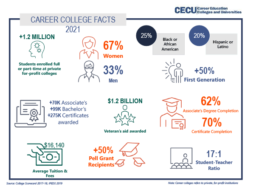
CECU State of the Sector an Executive Summary
13
0
By Career Education Colleges and Universities
At the request of CECU’s Board of Directors, they reached out to their Education Membership’s leaders to better understand the state of the sector school-by-school. This survey was sent out the week of April 13 – 17, with many of the responses in the week of April 20, 2020.58 percent of our schools’ leaders have provided a written response, a telephone interview or both. Here are the key summary observations, followed by some of the high points of their comments which help better define the analysis:
- The impact of the pandemic varies by both geography and types of programs. The schools in the Northeast are just getting killed with both current and future enrollments. Trade schools across the country are the least conducive to distance learning – both in the lack of onsite experience, and in older students rejecting distance education. Comments include:
-
- “We are a trade school, suspended all classes on March 26th.”
- “We are serving current students. But no new starts in past 4 weeks!”
- “Starts have decreased 40%.”
- “Enrollments decreased 30 – 40%, mainly in the trades.”
- A New York trade School: “We suspended all classes as of March 26th.”
- “Momentum for trade schools has died. Had 20 interviews and 0 enrollments!”
- “We have laid off 50 to 60% of faculty and staff.”
- “Nursing remains rock-solid. The trades are challenged.”
- “When citizens can’t leave their home, there’s no chance of enrollment.”
- The sector, like all of higher education, faces significant enrollment challenges. These enrollment challenges will continue for most through the summer. Optimism regarding enrollment begins with fall starts. These numbers are sobering in terms of their impact on the strength of individual schools, and the sector.
-
- Of the 58 schools responding:
- 19 have decreases in current enrollment. 6 schools are down 20% or more.
Some trade schools have just shut down for the moment rather than attempt distance learning. - 26 schools have steady, or very small decreases, in current enrollment.
- 4 schools are up – one credited this to a strong retention program.
- 19 have decreases in current enrollment. 6 schools are down 20% or more.
- Perhaps most troubling are the projections for new starts before fall.
- 33 schools are seeing decreases in new starts!13 of these schools are
witnessing decreases of 30% or higher! - 11 schools, mainly health schools or strong online programs, have seen an
increase in new starts. - All others respond their outcome is yet to be determined.
- 33 schools are seeing decreases in new starts!13 of these schools are
- Of the 58 schools responding:
- Schools are doing everything they can to keep and maintain faculty and staff. 58% of respondents have currently laid off five or less staff. Where reductions are happening, most schools are doing furloughs (temporary) rather than permanent layoffs. And many schools are providing continued health benefits, and more. Very few (less than 10%) indicated they have reduced salaries. Many schools have successfully applied for the SBA/PPP and are using it to keep staff employed.
-
- “Thanks to PPP, none now!”
- “Through PPP, FMLA, Sick Leave, and vacation time we’ve been able to maintain staff.”
- “Many staff are on furlough. We will bring back some now and the rest when the facilities reopen.”
- “Facility-based employees (janitors, receptionists) were laid off.”
- “No layoffs, but furloughed adjunct clinical instructors because no clinical sites open.”
- The loss of clinicals is hurting students; denying graduations! There is a growing concern in health and cosmetology schools, that state licensing boards are creating real problems due to their lack of flexibility in meeting clinicals.
-
- “In California we have 10,000 nurses set to graduate who won’t be able to because of the lack of clinicals.”
- “State Boards (Nursing and Cosmetology) are refusing to waive any requirements during the transition to online delivery.”
- “Most of the instructors laid off are adjunct clinical instructors because there are no clinicals.”
- “Many of the student LOA’s are also due to no clinicals.”
- “Once labs are re-opened, enrollments will be restored!”
- “No one has cancelled yet. This could change if we don’t solve the clinical issue.”
- “Our enrollment decrease is all in students when their externships are not available.”
- Most Project Enrollment Increases! 77% of respondents project some increase at some point in the future. (But, based upon previous experience one can conclude that only 77% predicting enrollment increase is actually low.) Many project that such increases will come later than expected – late fall. And many expect small increases due to the long- term impact of the pandemic on the over-all economy. No one sees double digit increases like the recession!
There is significant caution regarding the impact of this pandemic on the economy and hiring. Many schools worry that if there are no jobs, there will be no students seeking new occupational skills.
-
- “Shorter programs will soar!”
- “In places like NYC, enrollments won’t recover until people are comfortable riding crowded trains again. It is their only access to our schools.”
- “Student interest is high, but conversion to enrollments is not yet happening.”
- “Until unemployment benefits are exhausted, we don’t expect any enrollment increase.”
- “Three factors will impede enrollment returns/increases:
- If K-12 schools are closed, the adult students need to care for their kids.
- Confidence in the safety of; and, the availability of mass transit.
- Generous unemployment benefits minimize desire for new skills.”
- “Enrollment will increase in the fall, if Covid-19 closures are no longer in place.”
- “Definitely expect growth in demand for healthcare programs.”
- “Our goal: Enrollment levels off in summer and increases in fall.”
- “This is different than a recession. We see very different decision-making, and priorities. Many are hesitant to go out into today’s world.”
- Most schools want to use the institution support grants for enhanced technology within their schools. There is a clear recognition that we have entered a new era of education where online/distance education will be a key component. Most school leaders want to use the funds to both increase the school’s technology; and, to support those students needing access to such technology. Many school leaders were waiting for the Department guidance which has now arrived.
-
- “We did not offer distance education before. So we have significant expenses getting our online courses off the ground.”
- “We already had strong online programs, so we are directing the money to students.”
- “We will direct half to student needs; scholarships for those struggling with cost- of-attendance issues.”
- “We will spend the money to upgrade online advising, retention and tutoring.”
- “We hope to cover student notebooks, headsets, subscriptions and other technology needs of our students.”
- “We will hire more technology experts and more instructional designers for online delivery.”
- “We will invest in premium Zoom site licensing to enable faculty, staff and students with unlimited and enhanced remote access.”
- “Primarily this will cover the costs of high-quality simulation interactive programs.”
- “We will invest in technology and safety! We will purchase reusable masks for all (quite pricey); video conference licenses; lockdown browsers; and, laptops for those students in need.”
- How can CECU be most helpful in these times? CECU’s work related to the pandemic is highly recognized and appreciated. CECU is given credit for the Emergency Stabilization Grants. People see the CECU website, Guide, and Nicholas Kent’s unending expertise in answering questions as real benefits. They love CECU’s increased communications – and want more!
-
- “So far, you are seen as the most reliable source for immediate updates and accurate advice.”
- “Continue helping us interpret and follow the federal programs/policies.”
- “Please answer the critics, regarding our use of the Emergency Stabilization Grants.”
- “You should almost “over-inform” recognizing we need your guidance!”
- “Stay pro-active!”
- “Solve the 90/10 issue!”
- “Keep our students and our schools on par with all others during this crisis.”
- “The Guide for Distribution of Grants may be the best thing CECU has done.”
- “Create forums for school leaders to hear from and discuss with other leaders.”
- “We need CECU to collect and disseminate the stories of our student graduates on the front line of fighting this epidemic.”
- “We need CECU to tell the story of our schools taking care of our students during this crisis!”
- “There is growing concern about the impact of the 2020 elections on our sector. Get HEA done now, just in case!”
- “Position the sector for whatever the 2020 election brings.”
tags:
May 2020










